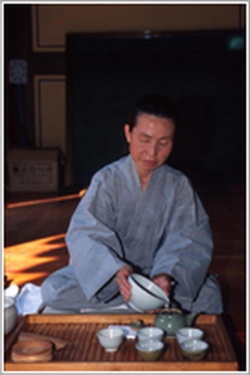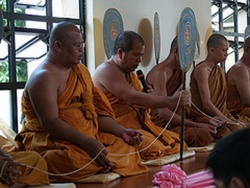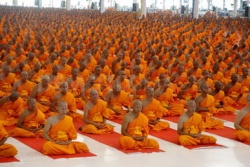Difference between revisions of "Anussati"
| Line 1: | Line 1: | ||
[[File:202345 n.jpg|thumb|250px|]] | [[File:202345 n.jpg|thumb|250px|]] | ||
<poem> | <poem> | ||
| − | '''[[Anussati]]''' ([[Pāli]]; [[Sanskrit]]: [[Anusmriti]]) means "[[recollection]]," "contemplation," "[[remembrance]]," "[[Meditation]]" and "[[Mindfulness]]." | + | '''[[Anussati]]''' ([[Pāli]]; [[Sanskrit]]: [[Anusmriti]]) means "[[recollection]]," "[[contemplation]]," "[[remembrance]]," "[[Meditation]]" and "[[Mindfulness]]." |
In [[Buddhism]], [[anussati]] refers to either: | In [[Buddhism]], [[anussati]] refers to either: | ||
| Line 13: | Line 13: | ||
In various contexts, the [[Pali literature]] and [[Sanskrit]] [[Mahayana]] [[sutras]] {{Wiki|emphasize}} and identify different enumerations of [[recollections]]. | In various contexts, the [[Pali literature]] and [[Sanskrit]] [[Mahayana]] [[sutras]] {{Wiki|emphasize}} and identify different enumerations of [[recollections]]. | ||
Three [[recollections]] | Three [[recollections]] | ||
| + | |||
The Three [[Recollections]]: | The Three [[Recollections]]: | ||
| − | |||
| − | |||
| − | |||
| − | The [[Dhammapada]] declares that The [[Buddha]]'s [[disciples]] who constantly practice [[recollection]] of the [[Three Jewels]] "ever [[awaken]] happily." According to the [[Theragatha]], such a practice will lead to "the height of continual [[Joy]]." | + | [[Recollection]] of The [[Buddha]] ([[Pali]] [[Buddhānussati]], Skt. [[Buddhanusmrti]], Tib. [[Sans- rgyas -rjes-su dran pa]]) |
| + | [[Recollection]] of the [[Dhamma]] ([[Pali]] [[Dhammā]]nussati, Skt. [[Dharmanusmrti]], Tib. [[Chos- rjes- su dran pa]]) | ||
| + | [[Recollection]] of [[The Sangha]] ([[Pali]] [[Saṅghānussati]], Skt. [[Sanghanusmrti]]: Tib. [[dge -hdun- rjes- su dran pa]]) | ||
| + | |||
| + | |||
| + | The [[Dhammapada]] declares that The [[Buddha]]'s [[disciples]] who constantly practice [[recollection]] of the [[Three Jewels]] "ever [[awaken]] happily." | ||
| + | |||
| + | According to the [[Theragatha]], such a practice will lead to "the height of continual [[Joy]]." | ||
| + | |||
Unlike other [[subjects]] of [[Meditative]] [[recollection]] mentioned in this article, the [[Three Jewels]] are considered "devotional contemplations." The [[Three Jewels]] are listed as the first three [[subjects]] of [[recollection]] for each of the following lists as well. | Unlike other [[subjects]] of [[Meditative]] [[recollection]] mentioned in this article, the [[Three Jewels]] are considered "devotional contemplations." The [[Three Jewels]] are listed as the first three [[subjects]] of [[recollection]] for each of the following lists as well. | ||
Five [[recollections]] | Five [[recollections]] | ||
| + | |||
On a [[Buddhist]] sabbath ([[Uposatha]]) day, in addition to practicing the [[Eight Precepts]], The [[Buddha]] enjoined a [[Disciple]] to engage in one or more of Five [[Recollections]]: | On a [[Buddhist]] sabbath ([[Uposatha]]) day, in addition to practicing the [[Eight Precepts]], The [[Buddha]] enjoined a [[Disciple]] to engage in one or more of Five [[Recollections]]: | ||
| + | |||
[[File:317584 1 1.jpg|thumb|250px|]] | [[File:317584 1 1.jpg|thumb|250px|]] | ||
[[Recollection]] of The [[Buddha]] | [[Recollection]] of The [[Buddha]] | ||
| Line 32: | Line 40: | ||
[[Recollection]] of [[Virtue]] ([[Sīlā]]nussati) | [[Recollection]] of [[Virtue]] ([[Sīlā]]nussati) | ||
[[Recollection]] of [[Deva]] [[virtues]] (devatānussati) | [[Recollection]] of [[Deva]] [[virtues]] (devatānussati) | ||
| + | |||
According to The [[Buddha]], for one who practices such [[recollections]]: "'his [[Mind]] is [[calmed]], and [[Joy]] arises; the [[Defilements]] of his [[Mind]] are abandoned.'" | According to The [[Buddha]], for one who practices such [[recollections]]: "'his [[Mind]] is [[calmed]], and [[Joy]] arises; the [[Defilements]] of his [[Mind]] are abandoned.'" | ||
| + | |||
| + | |||
[[Six recollections]] | [[Six recollections]] | ||
| + | |||
The [[Six Recollections]] are: | The [[Six Recollections]] are: | ||
| Line 44: | Line 56: | ||
[[Recollection]] of [[Virtue]] | [[Recollection]] of [[Virtue]] | ||
[[Recollection]] of [[Deva]] [[virtues]] | [[Recollection]] of [[Deva]] [[virtues]] | ||
| + | |||
The [[Buddha]] tells a [[Disciple]] that the [[Mind]] of one who practices these [[recollections]] "is not overcome with [[passion]], not overcome with [[aversion]], not overcome with [[Delusion]]. His [[Mind]] heads straight, ... gains [[Joy]] connected with the [[Dhamma]]..., [[rapture]] arises..., the [[Body]] grows [[calm]] ... [[experiences]] ease..., the [[Mind]] becomes [[concentrated]]." | The [[Buddha]] tells a [[Disciple]] that the [[Mind]] of one who practices these [[recollections]] "is not overcome with [[passion]], not overcome with [[aversion]], not overcome with [[Delusion]]. His [[Mind]] heads straight, ... gains [[Joy]] connected with the [[Dhamma]]..., [[rapture]] arises..., the [[Body]] grows [[calm]] ... [[experiences]] ease..., the [[Mind]] becomes [[concentrated]]." | ||
| + | |||
In [[Mahayana]] practice, the first [[six recollections]] were commonly [[taught]] and The [[Buddha]] anusmriti was particularly emphasized in many popular [[sutras]] such as the [[Medicine]] [[Buddha]] [[Sutra]]. | In [[Mahayana]] practice, the first [[six recollections]] were commonly [[taught]] and The [[Buddha]] anusmriti was particularly emphasized in many popular [[sutras]] such as the [[Medicine]] [[Buddha]] [[Sutra]]. | ||
Ten [[recollections]] | Ten [[recollections]] | ||
| − | As | + | As [[Ten Recollections]], the following are added to the [[Six Recollections]]: |
| + | |||
[[File:3215 m.jpg|thumb|250px|]] | [[File:3215 m.jpg|thumb|250px|]] | ||
| − | [[Recollection]] of [[Death]] ([[Mara]] | + | [[Recollection]] of [[Death]] ([[Mara ṇānussati]]) |
| − | [[Recollection]] of the [[Body]] (kāyagatā[[Sati]]) | + | [[Recollection]] of the [[Body]] (]]kāyagatā [[Sati]]]]) |
[[Recollection]] of the [[Breath]] ([[ānāpānassati]]) | [[Recollection]] of the [[Breath]] ([[ānāpānassati]]) | ||
| − | [[Recollection]] of [[peace]] (upasamānussati) | + | [[Recollection]] of [[peace]] (]]upasamānussati\\) |
| + | |||
| + | |||
| + | In the [[Pal] canon's]] [[Anguttara Nikaya]], it is stated that the practice of any one of these ten [[recollections]] leads to [[Nirvana]]. | ||
| − | |||
The [[Visuddhimagga]] identifies the Ten [[Recollections]] as useful [[Meditation]] [[subjects]] for developing [[Concentration]] needed to suppress and destroy the [[Five Hindrances]] during ones pursuit of [[Nibbana]]. | The [[Visuddhimagga]] identifies the Ten [[Recollections]] as useful [[Meditation]] [[subjects]] for developing [[Concentration]] needed to suppress and destroy the [[Five Hindrances]] during ones pursuit of [[Nibbana]]. | ||
| + | |||
[[File:348385.jpg|thumb|250px|]] | [[File:348385.jpg|thumb|250px|]] | ||
| − | In terms of the [[development]] of [[Meditative]] [[absorption]], [[Mindfulness]] of the [[Breath]] can lead to all [[four jhanas]], [[Mindfulness]] of the [[Body]] can lead only to the first [[Jhana]], while the eight other [[recollections]] culminate in pre-jhanic "access [[Concentration]]" ([[upacara | + | In terms of the [[development]] of [[Meditative]] [[absorption]], [[Mindfulness]] of the [[Breath]] can lead to all [[four jhanas]], [[Mindfulness]] of the [[Body]] can lead only to the first [[Jhana]], while the eight other [[recollections]] culminate in pre-jhanic "access [[Concentration]]" ([[upacara Samadhi]]). |
| + | |||
| + | |||
Specific [[subjects]] of [[recollection]] | Specific [[subjects]] of [[recollection]] | ||
| + | |||
As indicated in the above sets, the following are recollected [[subjects]] of either [[Meditation]] or [[devotion]]. | As indicated in the above sets, the following are recollected [[subjects]] of either [[Meditation]] or [[devotion]]. | ||
| Line 70: | Line 91: | ||
Iti pi so [[bhagavā]] [[arahaṃ]] sammā-saṃbuddho vijjācaraṇasaṃpanno [[sugato]] [[lokavidū]] [[anuttaro]] purisadammasārathī satthā devamanussānaṃ [[buddho bhagavā]] ti | Iti pi so [[bhagavā]] [[arahaṃ]] sammā-saṃbuddho vijjācaraṇasaṃpanno [[sugato]] [[lokavidū]] [[anuttaro]] purisadammasārathī satthā devamanussānaṃ [[buddho bhagavā]] ti | ||
| + | |||
'Indeed, the [[Blessed One]] is [[worthy]] and rightly [[self]]-[[Awakened]], [[consummate]] in [[Knowledge]] & conduct, well-gone, an expert with regard to the [[World]], unexcelled as a trainer for those [[people]] fit to be tamed, the [[Teacher]] of [[divine]] & [[human beings]], [[Awakened]], blessed.' | 'Indeed, the [[Blessed One]] is [[worthy]] and rightly [[self]]-[[Awakened]], [[consummate]] in [[Knowledge]] & conduct, well-gone, an expert with regard to the [[World]], unexcelled as a trainer for those [[people]] fit to be tamed, the [[Teacher]] of [[divine]] & [[human beings]], [[Awakened]], blessed.' | ||
| + | |||
It has been suggested that the [[Recollection]] of The [[Buddha]] identified in the [[Theravada]] [[canon]] might have been the basis for the more elaborately [[visual]] contemplations typical of [[Tibetan Buddhism]]. | It has been suggested that the [[Recollection]] of The [[Buddha]] identified in the [[Theravada]] [[canon]] might have been the basis for the more elaborately [[visual]] contemplations typical of [[Tibetan Buddhism]]. | ||
[[Recollection]] of the [[Dhamma]] | [[Recollection]] of the [[Dhamma]] | ||
| + | |||
The standard [[formula]] when recollecting the [[Dhamma]] is: | The standard [[formula]] when recollecting the [[Dhamma]] is: | ||
| Line 83: | Line 107: | ||
The standard [[formula]] when recollecting [[The Sangha]] is: | The standard [[formula]] when recollecting [[The Sangha]] is: | ||
| + | |||
'[[The Sangha]] of the [[Blessed One's]] [[disciples]] who have practiced well... who have practiced straight-forwardly... who have practiced methodically... who have practiced masterfully — in other words, the four types [of [[noble]] [[disciples]]] when taken as pairs, the eight when taken as {{Wiki|individual}} types — they are [[The Sangha]] of the [[Blessed One's]] [[disciples]]: [[worthy]] of gifts, [[worthy]] of [[Hospitality]], [[worthy of offerings]], [[worthy]] of [[respect]], the incomparable field of [[Merit]] for the [[World]].' | '[[The Sangha]] of the [[Blessed One's]] [[disciples]] who have practiced well... who have practiced straight-forwardly... who have practiced methodically... who have practiced masterfully — in other words, the four types [of [[noble]] [[disciples]]] when taken as pairs, the eight when taken as {{Wiki|individual}} types — they are [[The Sangha]] of the [[Blessed One's]] [[disciples]]: [[worthy]] of gifts, [[worthy]] of [[Hospitality]], [[worthy of offerings]], [[worthy]] of [[respect]], the incomparable field of [[Merit]] for the [[World]].' | ||
| Line 92: | Line 117: | ||
An example of one who has achieved such a [[Power]] is described in the following [[manner]] by The [[Buddha]] in the "[[Lohicca]] [[Sutta]]" (DN 12): | An example of one who has achieved such a [[Power]] is described in the following [[manner]] by The [[Buddha]] in the "[[Lohicca]] [[Sutta]]" (DN 12): | ||
| − | "With his [[Mind]] thus [[concentrated]], [[purified]], & bright, unblemished, free from defects, pliant, malleable, steady, & [[attained]] to imperturbability, he directs & inclines it to [[Knowledge]] of the [[recollection]] of {{Wiki|past}} [[lives]] (lit: previous homes). He recollects his manifold {{Wiki|past}} [[lives]], i.e., one [[birth]], two [[births]], three [[births]], four, five, ten, twenty, thirty, forty, fifty, one hundred, one thousand, one [[hundred thousand]], many [[aeons]] of [[cosmic]] contraction, many [[aeons]] of [[cosmic]] expansion, many [[aeons]] of [[cosmic]] contraction & expansion, [recollecting], 'There I had such a [[name]], belonged to such a {{Wiki|clan}}, had such an [[appearance]]. Such was my [[Food]], such my [[experience]] of [[pleasure]] & [[pain]], such the end of my [[Life]]. Passing away from that [[state]], I re-arose there. There too I had such a [[name]], belonged to such a {{Wiki|clan}}, had such an [[appearance]]. Such was my [[Food]], such my [[experience]] of [[pleasure]] & [[pain]], such the end of my [[Life]]. Passing away from that [[state]], I re-arose here.' Thus he recollects his manifold {{Wiki|past}} [[lives]] in their modes & details...." | + | |
| + | "With his [[Mind]] thus [[concentrated]], [[purified]], & bright, unblemished, free from defects, pliant, malleable, steady, & [[attained]] to imperturbability, he directs & inclines it to [[Knowledge]] of the [[recollection]] of {{Wiki|past}} [[lives]] (lit: previous homes). | ||
| + | |||
| + | He recollects his manifold {{Wiki|past}} [[lives]], i.e., one [[birth]], two [[births]], three [[births]], four, five, ten, twenty, thirty, forty, fifty, one hundred, one thousand, one [[hundred thousand]], many [[aeons]] of [[cosmic]] contraction, many [[aeons]] of [[cosmic]] expansion, many [[aeons]] of [[cosmic]] contraction & expansion, [recollecting], | ||
| + | |||
| + | 'There I had such a [[name]], belonged to such a {{Wiki|clan}}, had such an [[appearance]]. Such was my [[Food]], such my [[experience]] of [[pleasure]] & [[pain]], such the end of my [[Life]]. Passing away from that [[state]], I re-arose there. There too I had such a [[name]], belonged to such a {{Wiki|clan}}, had such an [[appearance]]. | ||
| + | |||
| + | Such was my [[Food]], such my [[experience]] of [[pleasure]] & [[pain]], such the end of my [[Life]]. Passing away from that [[state]], I re-arose here.' Thus he recollects his manifold {{Wiki|past}} [[lives]] in their modes & details...." | ||
</poem> | </poem> | ||
{{W}} | {{W}} | ||
Revision as of 10:46, 1 October 2015
Anussati (Pāli; Sanskrit: Anusmriti) means "recollection," "contemplation," "remembrance," "Meditation" and "Mindfulness."
In Buddhism, anussati refers to either:
specific Meditative or devotional practices, such as recollecting the sublime qualities of The Buddha, which lead to Mental tranquillity and abiding Joy; or,
Meditative attainment, such as the ability to recollect past lives.
Sets of recollections
In various contexts, the Pali literature and Sanskrit Mahayana sutras emphasize and identify different enumerations of recollections.
Three recollections
The Three Recollections:
Recollection of The Buddha (Pali Buddhānussati, Skt. Buddhanusmrti, Tib. Sans- rgyas -rjes-su dran pa)
Recollection of the Dhamma (Pali Dhammānussati, Skt. Dharmanusmrti, Tib. Chos- rjes- su dran pa)
Recollection of The Sangha (Pali Saṅghānussati, Skt. Sanghanusmrti: Tib. dge -hdun- rjes- su dran pa)
The Dhammapada declares that The Buddha's disciples who constantly practice recollection of the Three Jewels "ever awaken happily."
According to the Theragatha, such a practice will lead to "the height of continual Joy."
Unlike other subjects of Meditative recollection mentioned in this article, the Three Jewels are considered "devotional contemplations." The Three Jewels are listed as the first three subjects of recollection for each of the following lists as well.
Five recollections
On a Buddhist sabbath (Uposatha) day, in addition to practicing the Eight Precepts, The Buddha enjoined a Disciple to engage in one or more of Five Recollections:
Recollection of The Buddha
Recollection of the Dhamma
Recollection of The Sangha
Recollection of Virtue (Sīlānussati)
Recollection of Deva virtues (devatānussati)
According to The Buddha, for one who practices such recollections: "'his Mind is calmed, and Joy arises; the Defilements of his Mind are abandoned.'"
Six recollections
The Six Recollections are:
Recollection of The Buddha
Recollection of the Dhamma
Recollection of The Sangha
Recollection of Generosity (cāgānussati)
Recollection of Virtue
Recollection of Deva virtues
The Buddha tells a Disciple that the Mind of one who practices these recollections "is not overcome with passion, not overcome with aversion, not overcome with Delusion. His Mind heads straight, ... gains Joy connected with the Dhamma..., rapture arises..., the Body grows calm ... experiences ease..., the Mind becomes concentrated."
In Mahayana practice, the first six recollections were commonly taught and The Buddha anusmriti was particularly emphasized in many popular sutras such as the Medicine Buddha Sutra.
Ten recollections
As Ten Recollections, the following are added to the Six Recollections:
Recollection of Death (Mara ṇānussati)
Recollection of the Body (]]kāyagatā Sati]])
Recollection of the Breath (ānāpānassati)
Recollection of peace (]]upasamānussati\\)
In the [[Pal] canon's]] Anguttara Nikaya, it is stated that the practice of any one of these ten recollections leads to Nirvana.
The Visuddhimagga identifies the Ten Recollections as useful Meditation subjects for developing Concentration needed to suppress and destroy the Five Hindrances during ones pursuit of Nibbana.
In terms of the development of Meditative absorption, Mindfulness of the Breath can lead to all four jhanas, Mindfulness of the Body can lead only to the first Jhana, while the eight other recollections culminate in pre-jhanic "access Concentration" (upacara Samadhi).
Specific subjects of recollection
As indicated in the above sets, the following are recollected subjects of either Meditation or devotion.
Recollection of The Buddha
The standard formula when recollecting The Buddha is:
Iti pi so bhagavā arahaṃ sammā-saṃbuddho vijjācaraṇasaṃpanno sugato lokavidū anuttaro purisadammasārathī satthā devamanussānaṃ buddho bhagavā ti
'Indeed, the Blessed One is worthy and rightly self-Awakened, consummate in Knowledge & conduct, well-gone, an expert with regard to the World, unexcelled as a trainer for those people fit to be tamed, the Teacher of divine & human beings, Awakened, blessed.'
It has been suggested that the Recollection of The Buddha identified in the Theravada canon might have been the basis for the more elaborately visual contemplations typical of Tibetan Buddhism.
Recollection of the Dhamma
The standard formula when recollecting the Dhamma is:
'The Dhamma is well-expounded by the Blessed One, to be seen here & now, timeless, inviting verification, pertinent, to be realized by the wise for themselves.'
Recollection of The Sangha
The standard formula when recollecting The Sangha is:
'The Sangha of the Blessed One's disciples who have practiced well... who have practiced straight-forwardly... who have practiced methodically... who have practiced masterfully — in other words, the four types [of noble disciples] when taken as pairs, the eight when taken as individual types — they are The Sangha of the Blessed One's disciples: worthy of gifts, worthy of Hospitality, worthy of offerings, worthy of respect, the incomparable field of Merit for the World.'
Recollection of actual past lives
For one accomplished in Meditative Concentration, there is the possibility of attaining the recollection of one's own past lives (pubbenivāsānussati). In this case, anussati is not a Meditative subject to achieve jhanic absorption or devotional bliss; it is the actual fruit of practice.
An example of one who has achieved such a Power is described in the following manner by The Buddha in the "Lohicca Sutta" (DN 12):
"With his Mind thus concentrated, purified, & bright, unblemished, free from defects, pliant, malleable, steady, & attained to imperturbability, he directs & inclines it to Knowledge of the recollection of past lives (lit: previous homes).
He recollects his manifold past lives, i.e., one birth, two births, three births, four, five, ten, twenty, thirty, forty, fifty, one hundred, one thousand, one hundred thousand, many aeons of cosmic contraction, many aeons of cosmic expansion, many aeons of cosmic contraction & expansion, [recollecting],
'There I had such a name, belonged to such a clan, had such an appearance. Such was my Food, such my experience of pleasure & pain, such the end of my Life. Passing away from that state, I re-arose there. There too I had such a name, belonged to such a clan, had such an appearance.
Such was my Food, such my experience of pleasure & pain, such the end of my Life. Passing away from that state, I re-arose here.' Thus he recollects his manifold past lives in their modes & details...."



